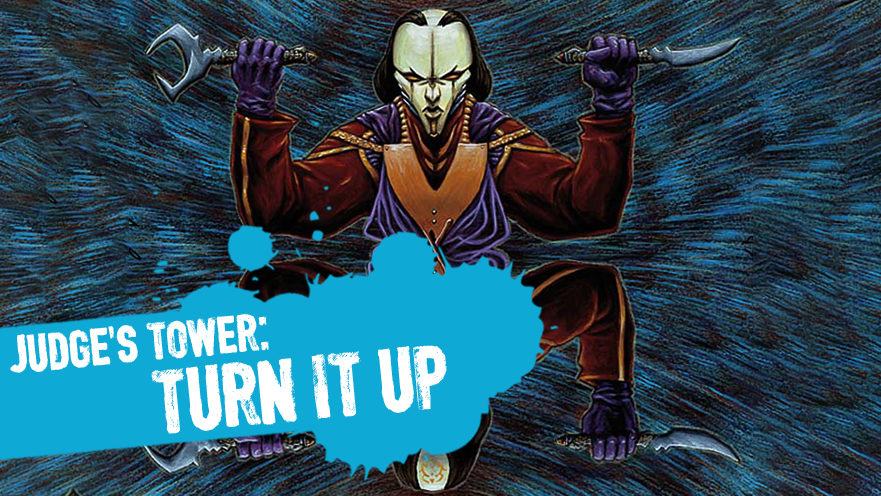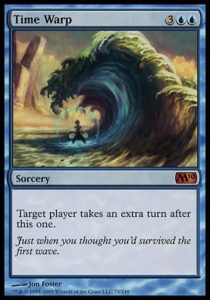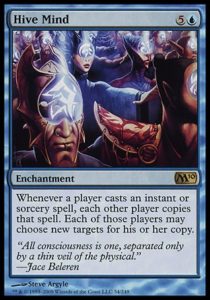When it comes to Magic, I fully subscribe to a school of thought that isn’t the most…friendly: Magic is inherently a zero-sum game. In any given game, there’s a certain amount of fun to be had, and I want to make sure that I have the most fun that I can every time I play. I can think of almost nothing that serves this purpose better than taking extra turns.
Taking extra turns is usually a straightforward process: if there’s an effect that gives you an extra turn after the current turn, then when the current turn ends, you just go back to the start of the turn cycle. “Until the end of the turn” effects reset, damage is removed from all creatures, and we’re back in your Untap step.
There are some weird situations that can come up, so we’ll look at a couple of them. These are going to come from two extreme ends of the Magic-playing spectrum: the first scenario will only ever come up in tournament play, and the second only applies to multiplayer games.
SCENARIO 1
Ash is playing against Nick in a Modern tournament. Ash is playing the Taking Turns deck. (C’mon, given what this article is about, what did you expect?) The match has been a long one, and during Ash’s turn in Game 3, time is called, and the players move into Last Five Turns. In their first Main Phase, Ash casts Time Warp, and then moves into their next turn. During their second turn, Ash casts Part the Waterveil for its Awaken cost, then ends the turn. During their third turn, Ash casts Snapcaster Mage, targeting and flashing back Time Warp after attacking with the 6/6 land. Finally, in their fourth consecutive turn, Ash attacks with the land and the Snapcaster, then passes to Nick.
Which turn of Last Five Turns is Nick moving into?
ANSWER
Nick is going to be playing Turn Four, so this is his last shot at taking the game from Ash.
The relevant ruling here comes from a document we haven’t really gotten into too much: The Magic Tournament Rules. Section 2.5 deals with End-of-Match Procedures, and states:
“If the match time limit is reached before a winner is determined, the player whose turn it is finishes his or her turn and five additional turns are played in total. This usually means that one player takes three turns and the other two, but a player taking extra turns may affect this.”
The MTR doesn’t exactly spell it out, but what this means is that the game doesn’t care who takes those last five turns, just that only five more total turns are played. Therefore, if a player manages to take extra turns after time has been called in a tournament, they get to effectively “steal” turns away from their opponent.
It’s a nifty little corner of the rules that doesn’t tend to come up too often. Now, for an even more interesting situation…
SCENARIO 2
Adam is playing a game of Commander against Nora, Noah, and Nigel. Nora is on Adam’s left, Noah is on Nora’s left, and Nigel completes the circle. At some point earlier in the game, Nigel had cast a Hive Mind, which is still out on the board. (There’s always one player who does something like this; I usually aim for them first.)
Adam casts Time Warp, and Hive Mind triggers, putting copies on the stack for other each player in Active Player, Nonactive Player order (we’ll get to it, don’t worry). There are no responses to the Time Warp or the Hive Mind trigger. So, Nigel’s copy of Time Warp resolves first, then Noah’s, then Nora’s, and finally Adam’s original copy.
Adam then passes the turn. Who, exactly, is he passing the turn to? And how will the turn order proceed after that?
ANSWER
Adam is passing the turn to himself, and the turn order will remain unaffected, proceeding clockwise around the table as normal.
The relevant rule (from the Comprehensive Rules) is the following:
“500.7. Some effects can give a player extra turns. They do this by adding the turns directly after the specified turn. If a player is given multiple extra turns, the extra turns are added one at a time. If multiple players are given extra turns, the extra turns are added one at a time, in APNAP order (see rule 101.4). The most recently created turn will be taken first.”
For completeness’s sake, here’s the text for rule 101.4:
“101.4. If multiple players would make choices and/or take actions at the same time, the active player (the player whose turn it is) makes any choices required, then the next player in turn order (usually the player seated to the active player’s left) makes any choices required, followed by the remaining nonactive players in turn order. Then the actions happen simultaneously. This rule is often referred to as the “Active Player, Nonactive Player (APNAP) order” rule.”
Rule 500.7 also takes care of another corner case that can come up. If a player in a multiplayer game were to manage to take an extra turn out of turn order (in the example game above, say Nigel Quickens out a Time Warp), they take that turn immediately after the active turn, and then turn order resumes as normal, going back to the player whose turn it would have been.
And that wraps up this edition of Judge’s Tower. As I said above, extra turns are fairly intuitive, but knowing the rules that apply to them can help keep the game flowing when weird situations come up. And keeping the game flowing means that you get to keep having fun and taking turns.
Header design: Justin Treadway
Header image: “Time Warp” by Pete Venters

Chris is the Marketing Communications Coordinator (and editor of the blog) at Card Kingdom. He would like to apologize to his son for not holding onto more cards from when he first started playing, as that likely would have paid for college. He enjoys pretty much all formats of Magic, but usually ends up playing decks that make other people dislike playing those formats with him.



